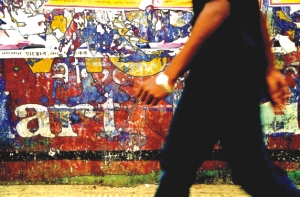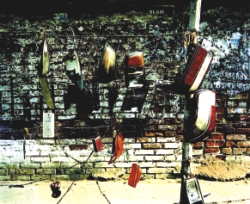|
Interview
Hidden City Charms
Barnaby Skinner
 A book on the walls of Dhaka might not seem like the most grabbing read to settle on. But whoever gets a chance to glance at Pascal Janovjak's and Bruno Ruhf's book "Les mures de Dacca" might just reconsider that. A book on the walls of Dhaka might not seem like the most grabbing read to settle on. But whoever gets a chance to glance at Pascal Janovjak's and Bruno Ruhf's book "Les mures de Dacca" might just reconsider that.
Janovjak and Ruhf have discovered an exceptionally beautiful side of Bangladesh's capital, a side that -- day in, day out -- is neglected by fifteen million city dwellers.
Coming to Dhaka in September 2002, the 30-year-old Janovjak spent three years working as Deputy Manager of the Alliance Française; setting up the French institute's cultural programme, language courses, concerts, exhibitions and film soirées.
 He was originally attracted to the city by the job offer at the Alliance and the rich cultural heritage of the subcontinent he hoped also to find in Bangladesh. "Concerning cultural heritage, I've been disappointed," he says and claims to see very little effort in preserving the country's heritage. "It took a student's initiative to at least document the ancient Kantanji temple at Dinajpur photographically, before it crumbles away to nothing," he says. He was originally attracted to the city by the job offer at the Alliance and the rich cultural heritage of the subcontinent he hoped also to find in Bangladesh. "Concerning cultural heritage, I've been disappointed," he says and claims to see very little effort in preserving the country's heritage. "It took a student's initiative to at least document the ancient Kantanji temple at Dinajpur photographically, before it crumbles away to nothing," he says.
Janovjak is more enthusiastic about the city's lively visual art scene. Janovjak says: "I'm full of admiration for what young and old visual artists are doing." Comparing it to Jordan and Lebanon, where he worked in a similar position, he sees visual arts as far more exciting in Dhaka.
 |
| Pascal Janovjak |
He especially admires the commitment of Tayeba Begum Lipi and Mahbubar Rahman, two influential contemporary artists. Not so much for their work as such, but for their fostering of young talent. During the three years at the Alliance Janovjak set up many exhibitions of likewise young and established artists.
Last March one of these exhibits showed Bruno Ruhf's pictures of city walls. Thirty three-year-old Ruhf arrived in Dhaka towards the end of 2004 and for several months archived city walls photographically; he highlighted walls that were battered by erosion, time and -- naturally -- pollution.
In some cases he also portrayed restless passers-by, seemingly unaware of the hidden beauty in their every day life. One photograph Ruhf has titled "Micro-ondes/Autoradio" shows what seems to be a limousine car park. Upon reveals a dark onlooker in the background. Janovjak explains: "What Ruhf did, was to take a picture of a weatherworn  poster at the building site of a multi-storey construction something most people wouldn't even glance at normally. However, taking a closer look, one sees that the images has so many layers." poster at the building site of a multi-storey construction something most people wouldn't even glance at normally. However, taking a closer look, one sees that the images has so many layers."
The exhibition of Ruhf's pictures at the Alliance in March lasted a fortnight and went so well that Janovjak organised a further exhibit in Chittagong. Then they took it a step further. "I came up with the idea to publish the images in a book," says Janovjak. He and Ruhf selected 27 pictures and put them next to texts by Janovjak -- sketches the Frenchman had written on his arrival in the city. "Looking at what I had written three years earlier, I realised how nicely they worked with what Bruno had done," he says.
In his sketches he depicts the emotions of a stranger fascinated by a strange country. Like Ruhf's photos Janovjak's images have several layers. He says: "Today I realise that the country I described then was almost surreal, fantastic, and the book is as much a description of an inner landscape as one of an actual Bangladesh."
Janovjak modelled his writing on Henri Michaux' (1899-1984) "Un Barbare en Asie", a book the French author wrote during his travels on the subcontinent in the 1930s.
 "The traffic, the noise, the poverty. This did get to me at first. But I have come to love Dhaka," says Pascal Janovjak. "The traffic, the noise, the poverty. This did get to me at first. But I have come to love Dhaka," says Pascal Janovjak.
After three years at the Alliance Française Janovjak has now given up his job as Deputy Director and plans to spend more time writing fiction in the future. He left the city in October travelling to France to discuss "Les mures de Dacca" with various French publishers.
Will he ever return to the Dhaka? Janovjak says: "It's a city, where trees seem to grow faster than flowers. It's a very exciting place for a writer to work. I'll miss it and can't rule out coming back some day."
Photographs: Bruno Ruhf
Copyright
(R) thedailystar.net 2005 |
